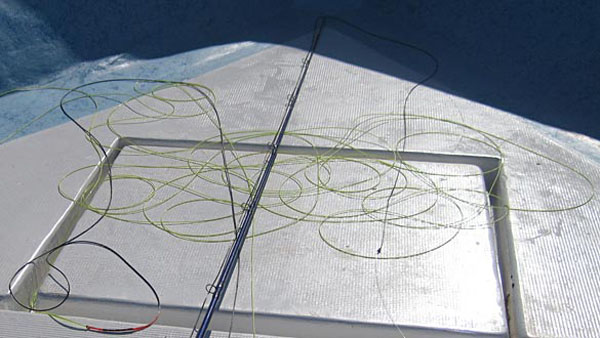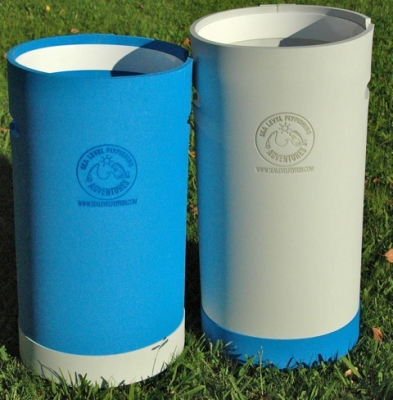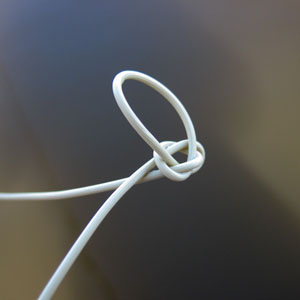By Grant Gisondo
[dropcap]I[/dropcap]t was a beautiful Wednesday morning in the last week of July. I was gently drifting north in 100-feet of water off the Breakers in Palm Beach, Forida in my 28-foot M ‘Ocean Grant’d console. I came prepared with a full box of my hand tied flies, and I had two boxes of glass minnows. I started chumming with sporadic handfuls of chum, trusting I’d find some albies. Sure enough, albies began breaking all over the surface. I picked up my fly rod and made a easy 50-foot cast and began my retrieve. No bites. I threw out another handful of chum and made another cast and the albies blew-up all around the boat. I made my retrieve. No bites. I made a quick fly change and tied on a Clouser thinking it would match my chum a bit better. Another handful of chum and a good cast. Same retrieve and same results – no bites. Again and again, all kinds of action and no bites. Ten casts later and slightly frustrated, I changed flies again and went with a chartreuse and white baitfish. Chum, cast, retrieve – nada. Ok, it’s the chum I figured. No chum, cast retrieve – nothing. Dozens of casts later, I tried a dark fly, then an all white fly with the same results. Then I moved the boat to a new spot and changed flies again. Tried chumming, then not chumming. I tried fast retrieve, slow retrieve and then no retrieve – just let the current rule. Finally, at around 10:00 o’clock in the morning, I saw an albie tracking my fly, it ate, turned and bolted. The the line came tight. It was wrapped around the boat cleat – fish gone. There I was on the bow dripping with sweat, my neck on fire from the sun, my mouth drier than sand and my arms were throbbing.
I have said it before and I will keep saying it, offshore fly fishing is not forgiving, maybe not as much as sight fishing for permit, but close, in my view. One mistake and you may not land that fish or even get a another strike!
Line management
If your fly-line is in a bucket, it won’t wrap around your leg, get stepped on or hung up on a cleat. Having 50-to 80-feet of fly line laying on the deck of a boat is a perfect recipe for disaster. Your fly-line will find a cleat, your feet, leg or anything else or make a bird’s nest when you get a strike. When you get a hook up with an ocean fish, like a king or an albie, they will not hesitate, shake their head like a trout in a deep river pool; they will put on the afterburners from the-get-go and fly-line will disappear at warp speed. If you’re lazy, like I was, the line will find a cleat. After all, that’s what cleats are designed to do, catch line. You have, of course, the option of purchasing cleats that pop into the rails of the boat so they lay flush while running, but if that costly upgrade isn’t in the budget, use a stripping bucket.
NOTE: When surf fishing I really like my $2.00 homemade stripping bucket that straps to my waist, but on a boat an attached basket is quite clumsy.
Here’s the solution
On my M ‘Ocean Grant’d I use a stripping bucket designed by Sea Level Fly Fishing. They make a model called the Bucket II “Travel.” It enables me to move the bucket anywhere on the boat that I’m fishing or leave the rod and line off of the and in the bucket while running to a different location. Its heavy enough so it won’t blow off the deck and deep enough that I can even keep my rod in it while repositioning the boat. There are many other stripping buckets available from ORVIS, Cabelas, Bass Pro Shops and others. Some are moveable and others are affixed to the boat.
My Sea Level bucket has a weighted base, providing excellent stability and it’s deep – making stripping into it easy. With this set-up I can simply drop the rod into the bucket with the line stripped out, ready to run to the next spot without having to reel in line. When I have someone else on board or if there’s a strong possibility of more than one species to be targeted simultaneously and need a completely different rod and set up. I can keep one rod in the tamer with line ready while the other rod is in the hands my angling partner.

This is one way to do it (tame the fly line in a bucket), but if you’re alone or two of you are fishing / captaining the boat you’ll find it somewhat of a pain.
The most effective way to manage fly line on a boat deck is the simplest; no shoes. Bare feet allow the angler to feel the line around him. He will know if the line has gotten underfoot or wrapped around his leg before it is too late.
If you’re spending time managing fly-line on the deck of your boat, you’re not having fun and you’re not fishing. All your focus and energy should be watching the water around and ahead of you and. most importantly, thinking about properly presenting the fly to the fish.
Clean your fly line
Many people don’t even realize that dirty fly line will get tangled much easier than clean fly line. This can be a very expensive mistake. If you fly line is dirty and laying on the deck or even in a stripping bucket and a fish strikes the tangled line will not shoot through the guides as the fish runs. What will happen is large tangled mess will eventually get caught on a guide and either break the rod or break the guides off the rod. This is also totally preventable. Just take your fly line and let it soak in a warm bath of water and soap than reel it back on your line while running it through a clean cloth and give it another rinse with fresh water and your done or simply purchase line cleaner at any fly shop.
Rusty is good name for a dog, but not for wire bite guards
Steel leaders are a must for kingfish, bluefish or any fish that has teeth. Steel and saltwater have yet to form a friendship. If you take an entire pack of steel leader material on the boat and it gets wet, chances are it will quickly develop rust spots on it. The rust spots are now the weak spot – will not be the test strength you bought and will break at that rust spot; every time. Remember rust is a corrosive reaction that slowly eats away the steel. So keep you leader material dry, don’t use leader that has rust spots on it. As a precaution, I change after each fishing trip. Also, after each hook-up, run your fingers down the leader itself and if it feels rough or like sandpaper; throw it away (not overboard either) and attach a new leader.
When in doubt, strip fight
Everyone loves the sound of a fly reel screaming when a fish runs like a freight train. It’s exciting and addictive. However, not every fish will run far enough to come tight on the reel or fought on the reel. I see this all the time. A smaller fish strikes and doesn’t run and anglers try to reel up all their slack line to fight the fish on the reel. Don’t do this! Simply, strip fight the fish. While you are reeling like crazy trying to get the fish on the reel, the line is either going slack or you are not paying attention to the fish. I see plenty of fish lost this way. Strip fighting a fish is really easy and can be fun. It’s not as pleasing as fighting a fish on the reel, but who cares you are hooked up!
I truly hope this brief article will help you land more fish and avoid some of the top problems people have. Always remember that we all have days where we lose fish or can’t find a single strike. Just enjoy yourself and have some fun. If you have any questions, contact me at moceangrantd@gmail.com
Note: My personal blog, on this site, will be open for business next week when Capt. Adrew Derr, our field editor, gets back from testing out the brookie population in the Adirondacks.
[information]
Contact:
Sealevel FlyFishing Adventures
877-616-0329
510-908-1809
ray@sealevelflyfish.com
6932 Monte Casino Way Sacramento, CA 95828
Price: $140.00
Manufacturer: Sea Level Flyfishing
Shipping Price: $15.00
Sizes:
24″
26″
28″
Color:
Delta Fog Grey
Horizon Blue
Coral Red
[/information]





Join the discussion One Comment